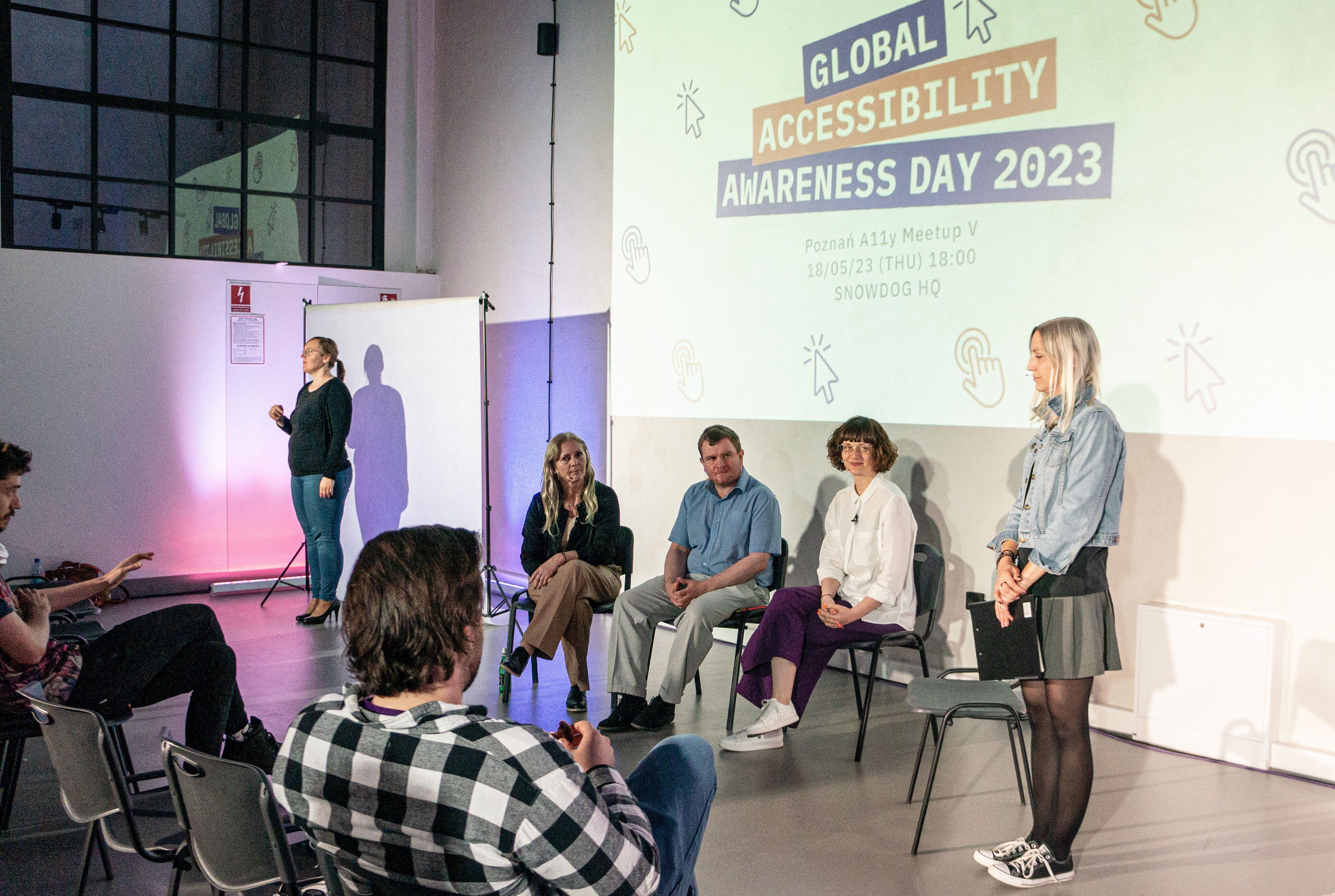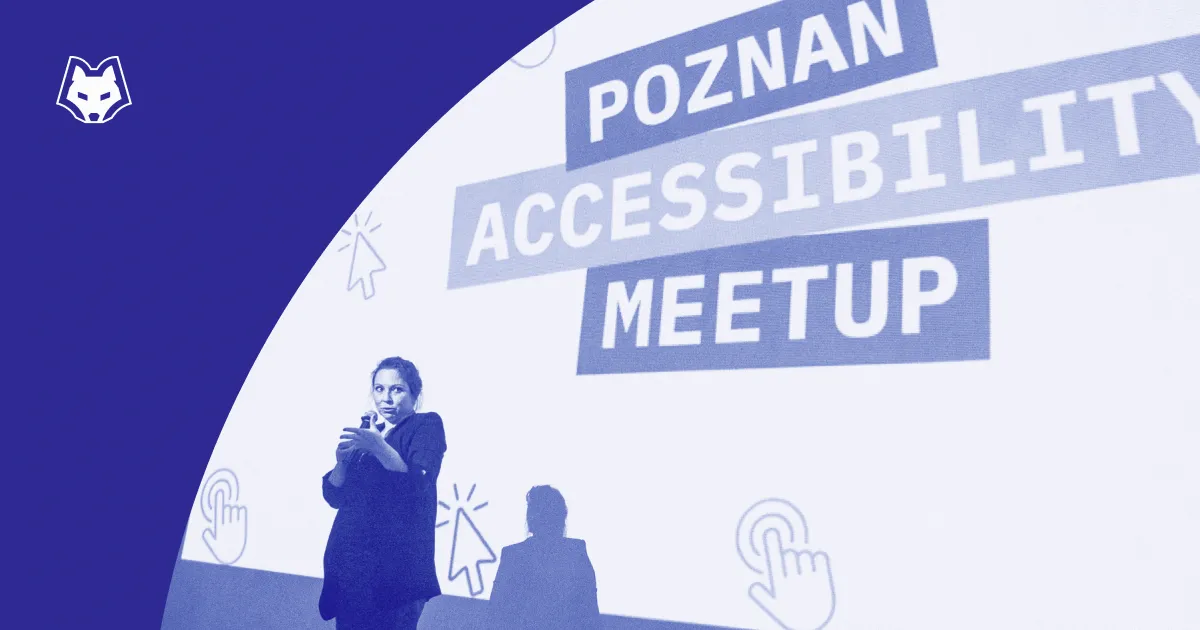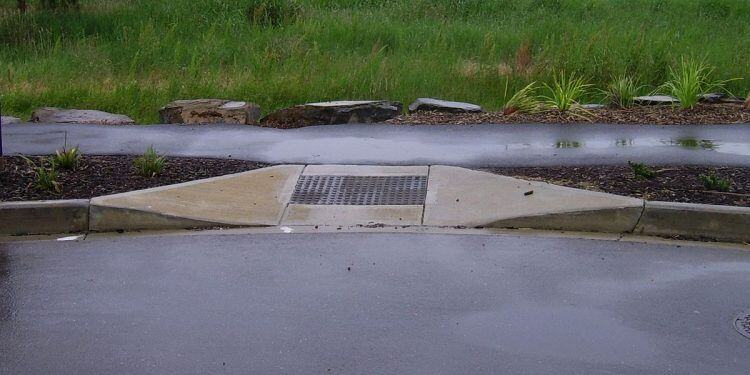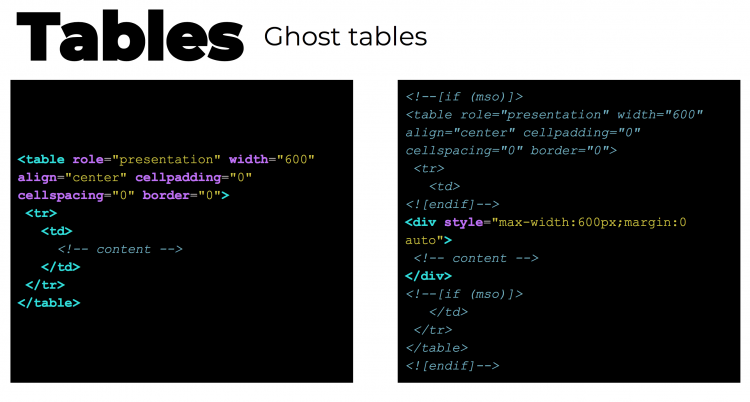
On the 18th of May, we met at 6 P.M. to celebrate Global Accessibility Awareness Day - a special date not only because of the GAAD itself but also because it was the 1st anniversary of our series of Poznań Accessibility Meetups - the 5th time we met at Snowdog HQ to build awareness about accessibility and understand even better the needs of people with disabilities. I've prepared a recap of all everything that happened on that day. So here we go!
1st Lecture - Sylwia Błach - Art Made with Assistive Technology
Our Senior Front-End Developer and Accessibility Specialist - Ania Karoń took over the role of the host that day (again) and started the event at 18:12 precisely. The first one to go on the stage was Sylwia Błach - a Polish writer, journalist, and blogger. She has published novels such as "Bo śmierć to dopiero początek" and "Kobieta w żółtej sukience," as well as short story collections like "Strach" and "Trzy lata strachu." Apart from her writing, she works as a Unity3D programmer and web developer, while also maintaining an Instagram profile, @VamppiV dedicated to literature, travel, and life with a wheelchair.

Sylwia's lecture was about art created by people with disabilities with assistive technology (AT). As she has SMA, she's very interested in the subject herself and has tested some of the AT mentioned in her lecture such as Eye tracking during our meetup in September 2022.
There is no "disabled art". Art is either good or bad. - Roman Roczeń
She started off by separating art types like painting and dancing and giving us examples of AT used to make this type of art and famous artists from that specific art type. Sylwia discussed the meaning of assistive technology in the process of creating art by people with limited abilities and the issues such people can face while creating.
Painting and Graphics Creation
The first artist she mentioned was Tommy Hollenstein, a painter who creates with his wheelchair's wheels. The artist suffers from quadriplegia and is using his AT - wheelchair as a brush. He famously said, "Find a way to adjust to every situation that seems to be impossible to adjust to".
Other artists named by Sylwia were e.g.:
- AJ Brockman - a digital artist with SMA from South Florida. He creates graphics on his computer.
- Jeff Lewis - a graphic designer who uses a tool called Tilt Brush to create amazing 3D graphics.
- Jody Xiong - an artist who created works of art such as "The Bloom". An art form created by the minds of people with disabilities.
Dancing
The first try to create a choreography with people in wheelchairs happened in the 80s in the USA. Dance seems to be an art form limited to people who can move freely. Thanks to many years of technological development, even people with motor disabilities can use special wheelchairs to dance. Sylwia introduced us to the Assistant Director of the dance program at the University of South Florida.
As a choreographer who often collaborates with dancers with disabilities, Merry Lynn Morris has long thought that traditional manual and power wheelchair designs were constraining. Her work in integrative dance, along with her experience growing up with a father who relied on a wheelchair, inspired her to invent a power wheelchair designed for artistic expression. Equipped with omnidirectional movement, a rotating seat, and a hands-free control, the chair enables dancers to explore new movement techniques, and may one day provide greater mobility in everyday life, too. - SciFri; A Chair Fit for Dancing
Music
Music is a genre of art where people with disabilities were not only present but also famous for a long time with figures such as Ray Charles, Stevie Wonder, Andrea Bocelli or Beethoven, but thanks to the new technology, people with different disabilities can enjoy creating it too.
Syliwa talked about a foundation called Drake Music whose goal is to create instruments for people with disabilities.
"At Drake Music we are leaders in music, disability and technology. We are innovators, educators, curators and advocates. We believe everyone has the right to express themselves creatively through music. We use new technologies and ideas to open up access to music for all. Our vision is a world where disabled and non-disabled musicians work together as equals. " - Drake Music
Creating music with technology
Sylwia talked about 2 very interesting tools for music creations
- EXA: The Infinite Instrument - it works with goggles: VR HTX Vive and Oculus - it's an app that you can download on Steam. You can use it to create music on various instruments such as piano, guitar, drums and many more. How does it work? In the 3D VR space, there are planted "ringers" - elements you can touch that play sounds. With different tools, you can hit, pull, move, change the size, mute, loop and do so many more things with them. Most of the sounds come from the Soundfont, but you can upload your own.
- EyeHarp - thanks to this app you can now compose music with your eyes! That's right! Zacharias Vamvakousis created an app called EyeHarp - it's software that allows you to play the piano (in the free version) and more than 20 other instruments (in the premium version). What's great is that this software works well with every AT that helps you to move the cursor around - an eye tracker or mouse. Here's an example of what you can do with it.
Installation Art
The last type of art mentioned by Sylwia is the Installation Art with an example of BlinkPopShift - founded by M. Eifler in San Francisco "is a non-profit that uses art and technology to prove disability is a hotbed of innovation." BlinkPopShift has many interesting art projects such as "Prosthetic Memory", "Invisible Sculpture" and "Masking Machine" - a series of digital photographies that uses Machine Learning to create masks of faces put one on top of the other.
Think outside the box
Many art techniques used by people with disabilities were not created especially for them. If you're looking for a new way to express yourself as a person with disabilities, think like Tommy Hollenstein - mentioned before, the artist who uses the wheels of his wheelchair to paint.
Use the technology that's already here:
- AI that can paint, create, draw - art can be writing good prompts
- Prosthetics - use them to augment your capabilities
- Furniture - that can make using the tools easier like height-adjustable tables
- 3D Printing - It is an art form you can use to create various projects: simple tools, sculptures, and even buildings
- Apps - there are people who create art with apps and software you'd never think of like Excel. Be creative!
2nd Lecture - Mateusz Pusty - Games accessible to everyone
The second lecture of the day was about gaming, because who doesn't love playing video games, am I right? So our speaker - Mateusz Pusty has decided to give us an introductory course on Game Accessibility. Mateusz is a Game Developer that works with Unity with more than 9 years of experience.
There are 3.23 billion gamers in the world and 1 billion people with disabilities. In the USA there are 226 million gamers and 43 million gamers with disabilities in the US. Mateusz made an assumption that there are more or less 648 million gamers worldwide.

Why are some games not accessible?
There are 2 main reasons behind it:
Reason #1
There is a lack of awareness of accessibility among the game producers. In those cases the non-accessible features, parts or whole games - it's not done intentionally. In the indie game industry, the small teams frequently don't know anything about accessibility and have never worked with someone who needs an accessible game. Moreover, most courses about game design or other tutorials don't even mention accessibility.
Reason #2
The game producers are aware of the issue but don't want to invest money and time into adjusting the games. Accessibility is not a priority, and they don't see it as something that brings profit to their company.
Accessibility in Games - Myth Busting
Making your game accessible does not only increase your sales by simply being more attractive to more gamers. It also does well for your PR and Marketing, or at least doesn't harm. If you don't think about accessibility from day one of game development, implementing it might be pricey. In the end, the thought behind the accessibility in games is simple - Why would you create a game that people can't play? Your goal should be to get as many people to play it as possible.
How to make games more accessible?
There are a few "categories" of issues you have to think about while working on accessibility:
1. Motor Disability
- The easiest way to make it more accessible is to allow to assign buttons. A great example of an all-around accessible game is The Last of Us 2. You can keep the pad vertically if you want.
- Change the type of action from tapping the button to holding
- Change the feedback - adjust the vibration and its intensity
2. Hearing Disability
- Don't communicate with the sound only - don't expect players to turn around if they hear an explosion behind their back - add subtitles to every possible situation
- Allow adjusting the loudness of separate elements of the game: effects, music, dialogues
- Adjustable subtitles - allow players to change the colour, background, and size of subtitles. A good idea is to add who's speaking before the quote: "Spider-Man: I'm on my way!"
3. Vision Disability
- Don't make items different just by changing the colour - for people with vision issues it's not enough - change the shape too.
- Use the right contrast between the elements e.g. put a light text on a dark background.
- Use the dyslectic-friendly font
- If it's possible apply a narrator - a person who reads everything through the game
- Give the option for people who have vision disabilities to play only with sound. For instance, Mortal Kombat makes you hear the character on the left only in the left earbud.
One of the most accessible games ever is The Last of US 2. Blind people can play and finish the game on their own. There's even a film series on YouTube with a blind person play through. - Mateusz Pusty
4. Cognitive Disability
- Give people access to tutorials and allow them to get back to previous dialogue.
- Let them see finished quests
- Give them a chance to turn off some of the effects like camera shake, motion blur, camera distance, the field of view, dolly zoom effect, full-screen effects, persistent centre dot etc.
- Allow the players to control the speed of dialogue. Add a simple "Press X to continue" instead of a non-stop dialogue.
- Add an option for Help/Tips in the game - sometimes people get stuck in a game and they need some help.
- Let players change the difficulty level - a great example is Elex where you can adjust the difficulty of every element.
5. Speech Disability
- Add chat based on text messages
To sum it up...
Accessibility in games is something that every game producer should care about. In the end, your goal should always be to get as many people to play the game as possible. In order to make accessibility a market standard all of the producers should share the info about their game's accessibility.
If your game is not accessible, but you'd like to change it - listen to the players. Frequently the gamers themselves will send you emails with tips. Listen and answer their feedback. And most importantly - test on the gamers who have disabilities. That's the best way to get insight and understand their needs better.
If you need more info about accessible games go to this page: https://gameaccessibilityguidelines.com/
The Last Part - Discussion Panel
In the discussion panel that was the last part of the evening, we had 3 people.
- Dominika Łukoszek - Manager of Digital Accessibility Team, UX Researcher and accessibility & simple language enthusiast,
- Mikołaj Rotnicki - Accessibility Specialist, its proponent and coach, and a Co-creator of solutions and mobile applications supporting visually impaired individuals.
- Beata Skrzypczak - the head of the Department of Services and Information Technologies at the Office of Digitization and Cybersecurity in the City Hall of Poznań, who fights against inaccessibility in public structures of the city.
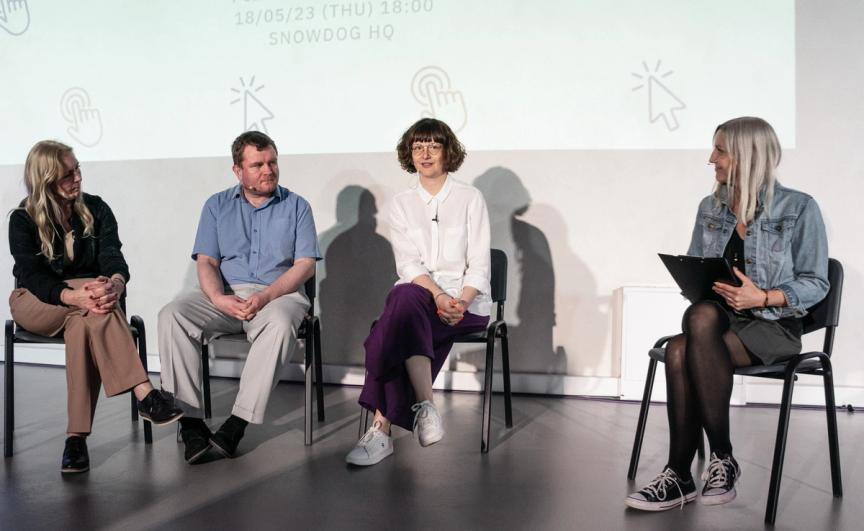
Ania Karoń who was a moderator of the conversation asked them some previously prepared questions about accessibility:
- Do you work with accessibility on a daily basis?
- Is there a visible change in digital accessibility in the last months?
- Is there an MVP of accessibility?
These are just examples, but I don't want to give out everything. Subscribe to our YouTube channel to see the full videos from all of those lectures and the discussion once they're uploaded. Special thank you goes to our PJM Translators and all the speakers! If you don't want to miss the next Meetup join our group. See you at the next Poznań Accessibility Meetup!
P.S. Here's a video from our previous meetup. Enjoy!

